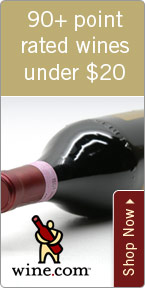Bubbling Over Old Champagne

Wednesday - September 08, 2006
| Share
 Del.icio.us
Del.icio.us“Champagne doesn’t age.”
I don’t know who originally said that, but I could not disagree more. If that person wrote that some Champagne is made to be drunk young, I could at least understand. But I personally like my Champagne to have plenty of bottle age on it. And I have had the privilege and opportunity to try plenty of “old” Champagne that still ranks as some of the greatest wine I have ever had.
So let’s start with the beginning of aging for Champagne. By law, non-vintage Champagne, meaning Champagne that is not labeled with a vintage on it and is a blend of two or more different years’produce, must be aged a minimum of 15 months after Jan. 1 following the year of harvest. Vintage Champagnes, which are made 100 percent from one year’s harvest, must be aged a minimum of three years.
Why do they have to be aged in the first place if Champagne doesn’t age? Well, during this aging period there is a chemical process occurring called autolysis. It’s a technical term and I won’t bore you with the details (Tom Stevenson does a fabulous job of describing it in his book World Encyclopedia of Champagne & Sparkling Wine). But it basically gives the Champagne its “champagne” flavor and character. It can be characterized as acacia and flowers, toasty and biscuity and even brandy-like aromas.
These are some of the intrinsic and typical character found in Champagne, things we all enjoy and expect. But after this initial aging the Champagne is disgorged. This process separates all the yeast particles from the clear wine. Otherwise we would have to strain out the yeast cells with our teeth!
Some say that without the yeast in contact with wine, there can be no autolysis. This may be true, but there is another reaction that has only been discovered recently which has been credited with the evolution of flavors in Champagnes even after they have been disgorged. This is called the Maillard Reaction, named after Louis-Camille Maillard, who studied these reactions in the early 20th century. This process is even more tedious than autolysis. Just know that it is the same reaction that is responsible for the colors and flavors of many different foods: caramel from milk and sugar; browning of bread into toast; the color of beer, chocolate, coffee and maple syrup; the flavor of roast meats; and the color of dried or condensed milk.
It has also been credited as giving Champagne its toasty, vanillin and Cognac-like qualities. These are flavors that we find in aged Champagne; things that I particularly enjoy.
OK, not everyone likes their Champagnes in this style. So those of you who don’t, you should drink your Champagnes as young and fresh as possible. For people in this category, I would recommend non-vintage blends because they are fresher, aged less than Vintage Champagnes.
Now if you’re like me, you like the flavors of mocha, coffee, brioche and vanilla bubbling from your glass, you should pick up some great vintage as well as a few of the “top” non-vintage Champagnes and store them in your cellar for some years before you pop the cork. You’ll see how interestingly they evolve into such splendid, deeper, richer and more complex wines. Mind you, they don’t have as much effervescence after a long period of aging. I still remember a bottle of 1961 Krug Vintage that bubbled only as I poured it into the glass, but it was an amazing bottle of Champagne, fully mature with all the complexity and richness that anyone could ask for.
All wines age. Some just get really crappy after a little or a long while. But any wine made with the quality of great Champagne will certainly age, improve and can ultimately be a stunning experience. You just have to decide how long to keep it.
* NV Diebolt Valois ($36). Young, fresh and vibrant. Made with 100 percent Grand Cru grapes, it shows a wonderful regal character.
* 1995 Krug Vintage ($225) The “youngest” vintage Krug at 11 years old. Superbly elegant, caressing and complex. It is still a baby and will blossom into greatness over the coming decade.
Roberto Viernes is a master sommelier. E-mail .(JavaScript must be enabled to view this email address)E-mail this story | Print this page | Comments (0) | Archive | RSS Comments (0) |
Most Recent Comment(s):












